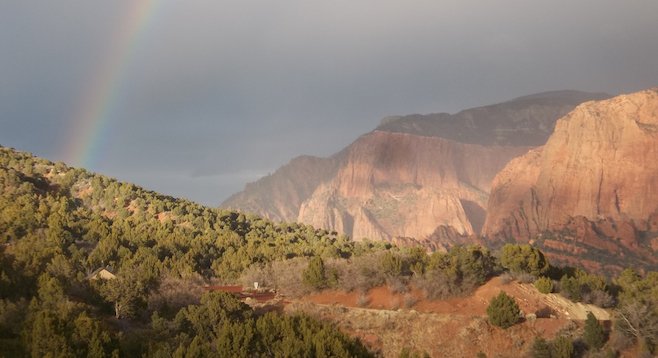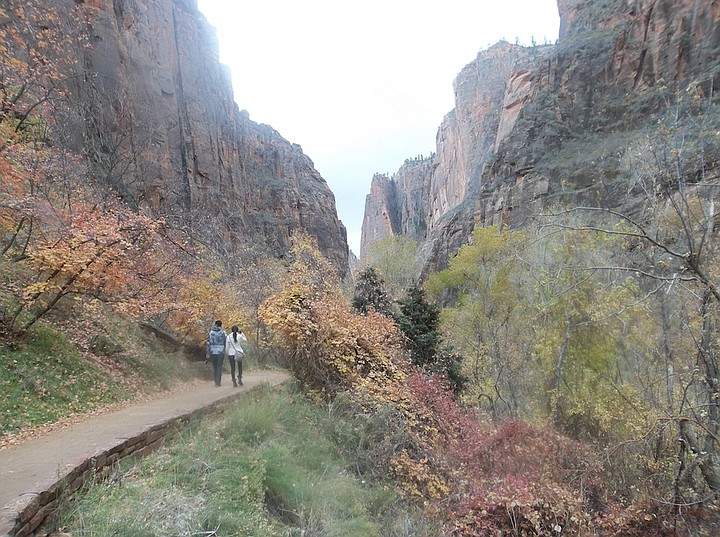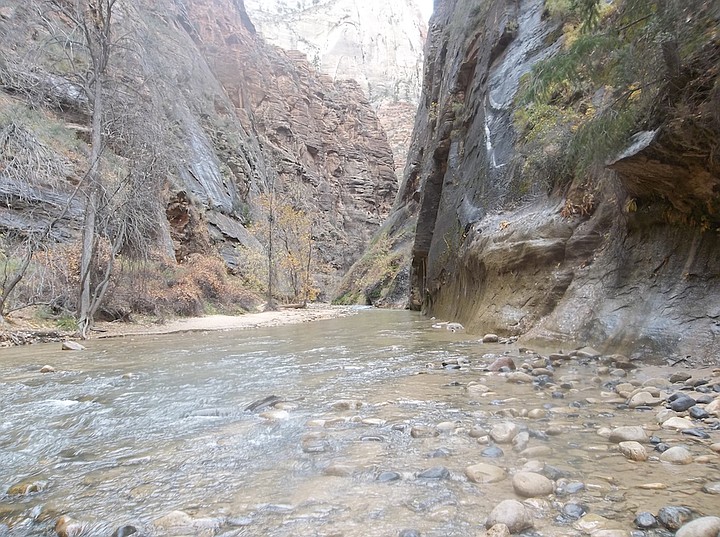 Facebook
Facebook
 X
X
 Instagram
Instagram
 TikTok
TikTok
 Youtube
Youtube

Just don’t get sidetracked in Vegas. That’s the key to arriving in Zion National Park from San Diego within a day with enough daylight left to explore the canyons.
The park, located in the southwest corner of Utah off I-15, is a hiker’s and nature lover’s wonderland. Early Mormon settlers named it “Little Zion” because it impressed them as an earthly slice of heaven. Those who visit and soak in its wonders can appreciate the designation.
Leaving early from Carlsbad, I arrived in St. George, Utah, that afternoon after a seven-hour drive up I-15 N. I used the time remaining before dark to explore a less-visited, less-crowded section of Zion known as Kolob Canyons. Kolob is accessible through a secondary entrance to the park off I-15 about 20 miles north of St. George. It’s definitely worth exploring if you have the time, but is probably best visited on a separate day than the main section of Zion.
As I traveled into Kolob, the weather was overcast and mildly drizzly. A few drops came down as a spectacular vista opened up. The huge red rocks reminded me of Sedona, Arizona. I drove to the end of the road and hiked the Timber Creek Overlook Trail. As I reached the end of the trail about a half-mile away, I was rewarded by the sun emerging and a glorious rainbow appearing over the canyon (above). The rocks burst alive with red and orange shades of color. I paused to appreciate the transcendent moment.
The only way to get into the main section of Zion during high season is to take a shuttle. It picks up at the Visitor’s Center and stops every 15 minutes or so at the primary spots of interest – including the Weeping Rock, Emerald Pool Trails near the Zion Lodge, and the Temple of Sinawava.

I happened to arrive on an off-season Saturday when the shuttle still operated on weekends. I had the choice of driving or shuttling, and decided on the latter. From the shuttle points, you can take easy hikes lasting less than an hour that can produce spectacular views, or more strenuous hikes that are potentially more rewarding for the more experienced and adventurous. These can last up to several days. Plan in advance and choose your hikes according to your stamina capacity.
It’s not just the huge, omnipresent sandstone cliffs that are alluring at Zion. Over 900 native species of plants can be found here, including a variety of wildflowers, ponderosa pine and cottonwood trees, and several species of cactus. In 2009, Congress protected about 85% of the park as wilderness under the 1964 Wilderness Act.
Each day at Zion brought a mixed bag of weather. There were raindrops and misty mornings, but these were overtaken by sunny afternoons that produced brilliant rainbows and a variety of light patterns and shades on the sandstone cliffs. I cooed about the variety of weather patterns to the shuttle driver and mentioned I was from San Diego.
“It’s nice there all the time,” she remarked, seemingly impressed.
Another local told me that Zion was her favorite of the Utah national parks because "you look up instead of down at Zion.” This is generally true, considering the sandstone cliffs that soar as high as 2,000 feet – but not if you take the Angels Landing walk. This hike offers a great bird’s-eye view and is recommended, unless you have a fear of hikes.

The Narrows is a hike between huge canyon walls and across a river (pictured). It can be precarious, though, and requires some advance research to prevent being caught in a flash flood. Like Angels Landing, it is a strenuous but rewarding hike.
You can take an easier short walk to the opening of the Narrows. Begin at the Temple of Sinawava and follow the Riverside Path. It may be crowded, but you'll be rewarded with gorgeous scenery. Even if the park is crowded, you can still find hikes that will bring you into solitude.
As I got off the shuttle at Zion Lodge, several mule deer were peacefully grazing in front of the building. I had lunch and discovered that an international film festival, the Red Rock Film Festival, was being hosted there. The films included some that had played at Sundance. A short hike from the lodge brought me past a waterfall to the Emerald Pools.
The scenic 24-mile drive to Mt. Carmel at the eastern entrance of the park is recommended, even if you came in from the southern entrance (likely if you're visiting from San Diego). You’ll drive through a 1.1-mile-long tunnel hewn of stone and admire some truly unique rock patterns. Checkerboard Mesa, near the eastern entrance, is a particularly interesting rock formation.
A 22-minute orientation film at the Human History Museum near the park’s entrance provides an enlightening look at the human and natural history of the area. Zion was occupied for thousands of years by Native Americans, first by the Puebolans (Anasazi Indians), then the southern Paiutes. The Mormons arrived in the 1850s, undoubtedly drawn by the natural beauty marked by the Virgin River flowing through huge, red sandstone cliffs.
There are plenty of lodging options in nearby Springdale and St. George. For the cheapest (and most potentially rewarding) lodgings, camp at one of the park’s campgrounds just inside the south entrance. You may need the savings for your stop in Vegas on the way back.


Just don’t get sidetracked in Vegas. That’s the key to arriving in Zion National Park from San Diego within a day with enough daylight left to explore the canyons.
The park, located in the southwest corner of Utah off I-15, is a hiker’s and nature lover’s wonderland. Early Mormon settlers named it “Little Zion” because it impressed them as an earthly slice of heaven. Those who visit and soak in its wonders can appreciate the designation.
Leaving early from Carlsbad, I arrived in St. George, Utah, that afternoon after a seven-hour drive up I-15 N. I used the time remaining before dark to explore a less-visited, less-crowded section of Zion known as Kolob Canyons. Kolob is accessible through a secondary entrance to the park off I-15 about 20 miles north of St. George. It’s definitely worth exploring if you have the time, but is probably best visited on a separate day than the main section of Zion.
As I traveled into Kolob, the weather was overcast and mildly drizzly. A few drops came down as a spectacular vista opened up. The huge red rocks reminded me of Sedona, Arizona. I drove to the end of the road and hiked the Timber Creek Overlook Trail. As I reached the end of the trail about a half-mile away, I was rewarded by the sun emerging and a glorious rainbow appearing over the canyon (above). The rocks burst alive with red and orange shades of color. I paused to appreciate the transcendent moment.
The only way to get into the main section of Zion during high season is to take a shuttle. It picks up at the Visitor’s Center and stops every 15 minutes or so at the primary spots of interest – including the Weeping Rock, Emerald Pool Trails near the Zion Lodge, and the Temple of Sinawava.

I happened to arrive on an off-season Saturday when the shuttle still operated on weekends. I had the choice of driving or shuttling, and decided on the latter. From the shuttle points, you can take easy hikes lasting less than an hour that can produce spectacular views, or more strenuous hikes that are potentially more rewarding for the more experienced and adventurous. These can last up to several days. Plan in advance and choose your hikes according to your stamina capacity.
It’s not just the huge, omnipresent sandstone cliffs that are alluring at Zion. Over 900 native species of plants can be found here, including a variety of wildflowers, ponderosa pine and cottonwood trees, and several species of cactus. In 2009, Congress protected about 85% of the park as wilderness under the 1964 Wilderness Act.
Each day at Zion brought a mixed bag of weather. There were raindrops and misty mornings, but these were overtaken by sunny afternoons that produced brilliant rainbows and a variety of light patterns and shades on the sandstone cliffs. I cooed about the variety of weather patterns to the shuttle driver and mentioned I was from San Diego.
“It’s nice there all the time,” she remarked, seemingly impressed.
Another local told me that Zion was her favorite of the Utah national parks because "you look up instead of down at Zion.” This is generally true, considering the sandstone cliffs that soar as high as 2,000 feet – but not if you take the Angels Landing walk. This hike offers a great bird’s-eye view and is recommended, unless you have a fear of hikes.

The Narrows is a hike between huge canyon walls and across a river (pictured). It can be precarious, though, and requires some advance research to prevent being caught in a flash flood. Like Angels Landing, it is a strenuous but rewarding hike.
You can take an easier short walk to the opening of the Narrows. Begin at the Temple of Sinawava and follow the Riverside Path. It may be crowded, but you'll be rewarded with gorgeous scenery. Even if the park is crowded, you can still find hikes that will bring you into solitude.
As I got off the shuttle at Zion Lodge, several mule deer were peacefully grazing in front of the building. I had lunch and discovered that an international film festival, the Red Rock Film Festival, was being hosted there. The films included some that had played at Sundance. A short hike from the lodge brought me past a waterfall to the Emerald Pools.
The scenic 24-mile drive to Mt. Carmel at the eastern entrance of the park is recommended, even if you came in from the southern entrance (likely if you're visiting from San Diego). You’ll drive through a 1.1-mile-long tunnel hewn of stone and admire some truly unique rock patterns. Checkerboard Mesa, near the eastern entrance, is a particularly interesting rock formation.
A 22-minute orientation film at the Human History Museum near the park’s entrance provides an enlightening look at the human and natural history of the area. Zion was occupied for thousands of years by Native Americans, first by the Puebolans (Anasazi Indians), then the southern Paiutes. The Mormons arrived in the 1850s, undoubtedly drawn by the natural beauty marked by the Virgin River flowing through huge, red sandstone cliffs.
There are plenty of lodging options in nearby Springdale and St. George. For the cheapest (and most potentially rewarding) lodgings, camp at one of the park’s campgrounds just inside the south entrance. You may need the savings for your stop in Vegas on the way back.
Comments